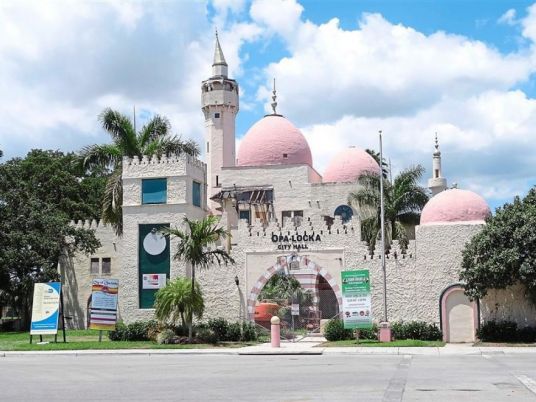
The idea was to conjure up a slice of Middle Eastern splendour… in Florida.
Up went minarets and pastel-coloured domes, and streets got names like Ali Baba and Aladdin. The result – the town of Opa-locka – came to house the largest concentration of Moorish revival architecture in the US.
Now, however, it is just another poor, crumbling American community, albeit one fighting to resurrect itself with art.
Opa-locka – the name comes from a Seminole Native American Indian word meaning big island covered with trees and swamps – was founded in 1926 as part of a construction boom in south-east Florida.
The surge saw other communities also arise with particular kinds of architecture, such as Coral Gables, with Mediterranean-style buildings, or Miami Springs and its taste of the Spanish missions that dotted the US south-west.
“During the 1920s there is this real state-craze, a lot of people moving to Florida. They want to make a quick profit,” says Jose Vazquez, a professor at the School of Architecture and Interior Design at Miami Dade College. “One of the things that would make these different developments unique was architecture,” he adds.
The exotic lure that the Middle East stirred in the US inspired Glenn Curtiss, the millionaire entrepreneur who was the driving force behind Opa-locka. “So Orient, or the idea of the Orient, 1920. We are talking about the discovery of the tomb of Tutankhamun, also we had big movie blockbusters like The Thief Of Baghdad,” Vazquez says.

Volunteers walk by a mural during an arts initiative to embellish the town’s streets earlier this year. Photo: AFP
While the town was under construction, however, the real estate bubble burst. A hurricane in 1926 also proved catastrophic for the project. Then Curtiss died in 1930, taking with him any hope of completing it.
Of 100 Moorish-style buildings that were projected, only 70 were built. These days only 50 or so remain, in varying degrees of conservation or decay, says Vazquez.
Twenty buildings here feature on the US national registry of historic buildings, including the town hall, which boasts towering minarets, six domes, and ample gardens. It was the centrepiece of Curtiss’s grand plan. Now it is being restored.
Indeed, the oasis that Curtiss foresaw dried up, and Opa-locka slid into decline. The nadir came toward the end of the 20th century as crime spread and the city earned a reputation for violence.
The image has stuck, even today. Forty percent of its 16,000 residents – 65% of them black and 30% Latino – live under the poverty line. “Here, all there is are bars and churches. Bars and churches,” says Fernando Campos, age 65.
The Opa-locka Community Development Corporation has spearheaded efforts to give the town a facelift, especially with art projects but also through housing construction and restoration of public parks and other green areas – all with public and private subsidies.
The goal is to turn Opa-locka into a tourist draw that will appeal to some of the millions of people who visit nearby Miami every year, says Willie Logan, president of the community development group.

The towns streets are named after characters from of the story of A Thousand And One Nights. Photo: AFP
“The city is very unique, in the sense that it has its own airport, its own train station, its Moorish architecture. It is a world-class city that has the potential to be a great city,” says Logan.
The community development group has invested US$2.5mil (RM9.5mil) in art projects and the results are becoming apparent: murals, spruced-up urban areas, and a community centre with a growing calendar of cultural events. Middle-Eastern style is the underlying theme that holds all the projects together.
Dozens of volunteers recently refurbished and decorated several blocks along Ali Baba Avenue, applying fresh coats of paint and motifs based on the lines and geometrical patterns typical of Middle-Eastern architecture. Some artists, rather than settle in hip areas of Miami, are opting for Opa-locka.
“When I first moved here no one believed that we were here to try to actually make changes,” says Germane Barnes, an architect and designer who hails from Los Angeles. “No one believed me when I said that I was actually going to move into the neighbourhood.”
People are noticing colour coming back to the streets.
“It is unique. You come here and you are transported to a place that you never suspected you would ever see here,” says Vazquez. “For me that is what makes Opa-locka so unique and so worth preserving.”




